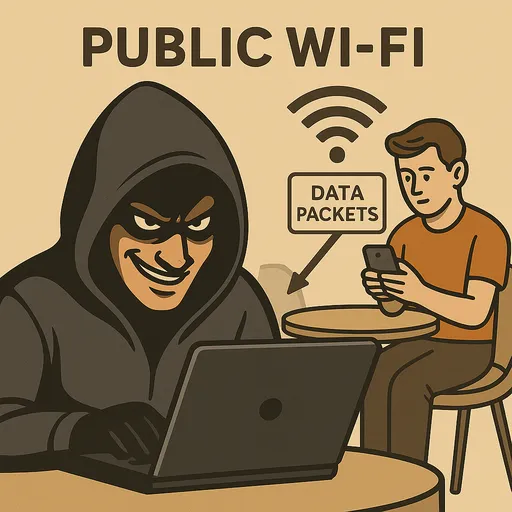Free Wi-Fi available in public places like cafes, airports, and hotels is a symbol of convenience. Many connect without a second thought, relieved to enjoy the internet without worrying about data charges. However, behind this 'sweet temptation' lies a serious risk that threatens your valuable personal information and device security. How does public Wi-Fi work, and just how vulnerable can your digital life become when you connect unprotected?
Basic Operation of Public Wi-Fi and Its Inherent Risks: A Look at Your Vulnerabilities from an Attacker's Perspective
Generally, public Wi-Fi networks have very weak security settings or are entirely unencrypted open networks. This is like having a loud conversation in a crowded square where anyone can hear you. The moment your smartphone, laptop, or tablet connects to public Wi-Fi, your data is exposed to risks in the following ways.
1. Data Sniffing: The Moment Your Information is Exposed in Plain Text
When an attacker connects to the same public Wi-Fi network, they can use a tool called a Packet Sniffer to monitor all data moving across the network. If you access an unencrypted HTTP (no 's' at the end) website, all the information you send and receive is displayed in plain text right in front of the attacker.

-
Scenario: After connecting to the café Wi-Fi, you log in to an outdated website that starts with
http://(e.g., a specific community bulletin board, news site). -
Attacker's Action: An attacker connected to the same Wi-Fi uses tools like Wireshark to monitor your network traffic in real-time. The moment you enter and send your login information, the following data may be captured in plain text on the attacker's screen.
``` POST /login Host: oldforum.com User-Agent: ... Content-Type: application/x-www-form-urlencoded Content-Length: ...
username=your_id&password=your_password123! ```
-
Result: Your username and password, along with the content of posts you've made on that site, personal messages, and even credit card or bank account information can be fully exposed to the attacker. Even using
HTTPSdoes not guarantee security; past connections to the site throughHTTPdue to a redirect or server configuration errors can leave you vulnerable to partial data exposure through a 'downgrade attack'.
2. Man-in-the-Middle Attack (MitM): The Sly Interceptor Between You and the Server
The man-in-the-middle attack is one of the most dangerous methods where an attacker inserts themselves between the user (you) and the website (server) to intercept and even alter your communication. The attacker may disguise themselves as the true Wi-Fi hotspot or deceive users on the network through tactics like ARP spoofing.
Scenario 1 (Fake Hotspot):
You’re looking for Wi-Fi in a café, and besides "Free_Cafe_WiFi," you see a similarly named hotspot called "Cafe_Free_WiFi". You innocently connect to the fake hotspot.
-
Attacker's Action: Now the attacker intercepts all your internet requests. When you try to access your banking app, the attacker redirects you to a prepared fake banking site that looks almost identical to the real one. You enter your username and password without any suspicion.
-
Result: All the information you input is sent directly to the attacker, not the bank's server. The attacker can use this information to gain access to your actual bank account. Even HTTPS connections can be compromised if the attacker uses a fake SSL certificate to deceive your browser.
Scenario 2 (DNS Spoofing):
You connect to a specific shopping site https://shopping.com.
-
Attacker's Action: The attacker on the same Wi-Fi network intercepts your DNS requests, spoofing the IP address of
shopping.comto that of a phishing site they created. -
Result: Your browser connects to the attacker's phishing site instead of the real
shopping.com. You continue shopping, and all the credit card information and personal details you input get forwarded to the attacker. They can even access your browsing history.
3. Session Hijacking: The Risk of Your Login State being Stolen
After logging in, a 'session cookie' is used to maintain a user session. If this session cookie is exposed, the attacker can access your account while you're still logged in to the website.
-
Scenario: You log in to your social media account over public Wi-Fi. Even if the social media site uses HTTPS, network settings misconfiguration or certain attack techniques can expose the session cookie.
-
Attacker's Action: The attacker intercepts your session cookie and injects it into their own browser when they access the social media site.
-
Result: The attacker becomes logged into your account, allowing them to manipulate your social media without knowing your password or read your personal information. They could send malicious messages to friends or leak your personal photos, leading to terrible situations.
4. Malware Infection and Port Scanning: Malicious Code Targeting Your Device
Public Wi-Fi often allows communication between devices connected to the network. This means that attackers can pose a direct threat to your device.
-
Scenario: You are working on a laptop connected to public Wi-Fi.
-
Attacker's Action: The attacker discovers your laptop's IP address on the same network and uses a port scanner to search for open ports on your laptop. If security settings are weak or if there is unpatched software with open ports, the attacker may try to inject malicious code or remotely control your device through that port.
-
Result: Malware like ransomware or spyware could be installed on your laptop. This can lead to encryption of personal files, system crashes, and data leaks, potentially turning your laptop into a 'zombie PC' used for other attacks.
Conclusion: Will You Give Up the Benefits of Civilization or Use Them Wisely?
It can be shocking to realize that such serious security risks lurk behind the convenience of public Wi-Fi. So, should we completely give up this convenient aspect of modern civilization? Advising you to completely stop using free Wi-Fi is neither realistic nor responsible.
The key is to recognize the risks and take appropriate security measures while using it. Accessing public Wi-Fi without following safety rules is like leaving your home unlocked while you are away.
In the next installment, we will explore the most powerful and essential defenses you can use to protect your important information and devices in a public Wi-Fi environment. Especially, you may have heard of the term "VPN (Virtual Private Network)", but what exactly is it, what does it mean, and how can VPNs safely protect your devices and communication records from prying eyes? We will delve deeply into these topics. Let’s discover together in the next post, the first step towards smart usage.

There are no comments.